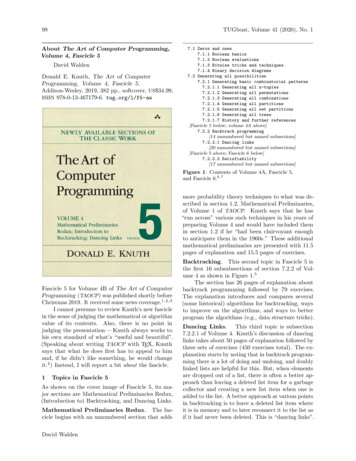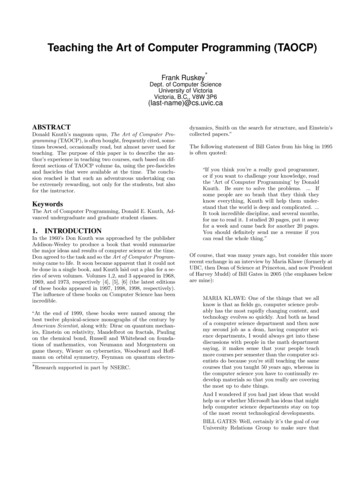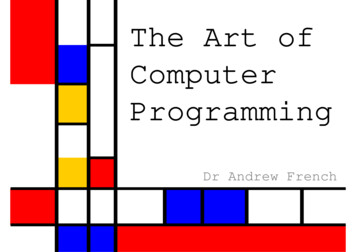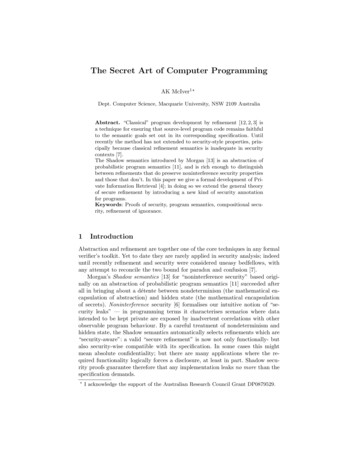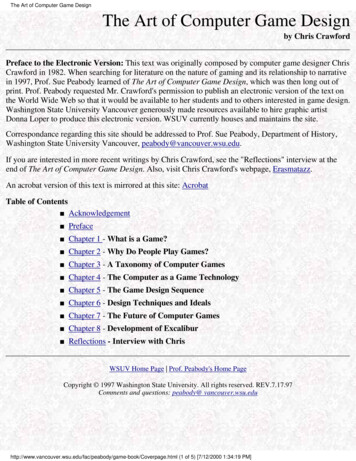
Transcription
THE ART OFCOMPUTER PROGRAMMINGMissing pages from select printings of Knuth, The Art of Computer Programming, Volume 4A(ISBN-13: 9780201038040 / ISBN-10: 0201038048).Copyright 2011 Pearson Education, Inc. All rights reserved.
DONALD E. KNUTH Stanford University677ADDISON–WESLEYMissing pages from select printings of Knuth, The Art of Computer Programming, Volume 4A(ISBN-13: 9780201038040 / ISBN-10: 0201038048).Copyright 2011 Pearson Education, Inc. All rights reserved.
Volume 4A / Combinatorial Algorithms, Part 1THE ART OFCOMPUTER PROGRAMMINGBoston · Columbus · Indianapolis · New York · San FranciscoAmsterdam · Cape Town · Dubai · London · Madrid · MilanMunich · Paris · Montréal · Toronto · Mexico City · São PauloDelhi · Sydney · Hong Kong · Seoul · Singapore · Taipei · TokyoMissing pages from select printings of Knuth, The Art of Computer Programming, Volume 4A(ISBN-13: 9780201038040 / ISBN-10: 0201038048).Copyright 2011 Pearson Education, Inc. All rights reserved.
The poem on page 437 is quoted from The Golden Gate by Vikram Seth (New York:c 1986 by Vikram Seth.Random House, 1986), copyright ⃝The author and publisher have taken care in the preparation of this book, but make noexpressed or implied warranty of any kind and assume no responsibility for errors oromissions. No liability is assumed for incidental or consequential damages in connectionwith or arising out of the use of the information or programs contained herein.The publisher offers excellent discounts on this book when ordered in quantity for bulkpurposes or special sales, which may include electronic versions and/or custom coversand content particular to your business, training goals, marketing focus, and brandinginterests. For more information, please contact:U.S. Corporate and Government Sales(800) 382–3419corpsales@pearsontechgroup.comFor sales outside the U.S., please contact:International Salesinternational@pearsoned.comVisit us on the Web: informit.com/awLibrary of Congress Cataloging-in-Publication DataKnuth, Donald Ervin, 1938The art of computer programming / Donald Ervin Knuth.xvi,883 p. 24 cm.Includes bibliographical references and index.Contents: v. 1. Fundamental algorithms. -- v. 2. Seminumericalalgorithms. -- v. 3. Sorting and searching. -- v. 4a. Combinatorialalgorithms, part 1.Contents: v. 4a. Combinatorial algorithms, part 1.ISBN 978-0-201-89683-1 (v. 1, 3rd ed.)ISBN 978-0-201-89684-8 (v. 2, 3rd ed.)ISBN 978-0-201-89685-5 (v. 3, 2nd ed.)ISBN 978-0-201-03804-0 (v. 4a)1. Electronic digital computers--Programming. 2. Computeralgorithms.I. Title.QA76.6.K64 1997005.1--DC2197-2147Internet page http://www-cs-faculty.stanford.edu/ knuth/taocp.html containscurrent information about this book and related books.See also http://www-cs-faculty.stanford.edu/ knuth/sgb.html for informationabout The Stanford GraphBase, including downloadable software for dealing withthe graphs used in many of the examples.And see http://www-cs-faculty.stanford.edu/ knuth/mmix.html for basic information about the MMIX computer.Electronic version by Mathematical Sciences Publishers (MSP), http://msp.orgc 2011 by Pearson Education, Inc.Copyright ⃝All rights reserved. Printed in the United States of America. This publication isprotected by copyright, and permission must be obtained from the publisher prior toany prohibited reproduction, storage in a retrieval system, or transmission in any formor by any means, electronic, mechanical, photocopying, recording, or likewise. Forinformation regarding permissions, write to:Pearson Education, Inc.Rights and Contracts Department501 Boylston Street, Suite 900Boston, MA 02116Fax: (617) 671-3447ISBN-13 978-0-201-03804-0ISBN-100-201-03804-8Third digital release, March 2017Missing pages from select printings of Knuth, The Art of Computer Programming, Volume 4A(ISBN-13: 9780201038040 / ISBN-10: 0201038048).Copyright 2011 Pearson Education, Inc. All rights reserved.
PREFACETo put all the good stuff into one book is patently impossible,and attempting even to be reasonably comprehensiveabout certain aspects of the subject is likely to lead to runaway growth.— GERALD B. FOLLAND, “Editor’s Corner” (2005)The title of Volume 4 is Combinatorial Algorithms, and when I proposed itI was strongly inclined to add a subtitle: The Kind of Programming I Like Best.My editors have decided to tone down such exuberance, but the fact remainsthat programs with a combinatorial flavor have always been my favorites.On the other hand I’ve often been surprised to find that, in many people’sminds, the word “combinatorial” is linked with computational difficulty. Indeed,Samuel Johnson, in his famous dictionary of the English language (1755), saidthat the corresponding noun “is now generally used in an ill sense.” Colleaguestell me tales of woe, in which they report that “the combinatorics of the situation defeated us.” Why is it that, for me, combinatorics arouses feelings ofpure pleasure, yet for many others it evokes pure panic?It’s true that combinatorial problems are often associated with humongouslylarge numbers. Johnson’s dictionary entry also included a quote from EphraimChambers, who had stated that the total number of words of length 24 or less,in a 24-letter alphabet, is 1,391,724,288,887,252,999,425,128,493,402,200. Thecorresponding number for a 10-letter alphabet is 11,111,111,110; and it’s only3905 when the number of letters is 5. Thus a “combinatorial explosion” certainlydoes occur as the size of the problem grows from 5 to 10 to 24 and beyond.Computing machines have become tremendously more powerful throughoutmy life. As I write these words, I know that they are being processed by a “laptop” whose speed is more than 100,000 times faster than the trusty IBM Type 650computer to which I’ve dedicated these books; my current machine’s memorycapacity is also more than 100,000 times greater. Tomorrow’s computers will beeven faster and more capacious. But these amazing advances have not diminishedpeople’s craving for answers to combinatorial questions; quite the contrary. Ouronce-unimaginable ability to compute so rapidly has raised our expectations,and whetted our appetite for more — because, in fact, the size of a combinatorialproblem can increase more than 100,000-fold when n simply increases by 1.Combinatorial algorithms can be defined informally as techniques for thehigh-speed manipulation of combinatorial objects such as permutations or graphs.We typically try to find patterns or arrangements that are the best possible waysto satisfy certain constraints. The number of such problems is vast, and the artvMissing pages from select printings of Knuth, The Art of Computer Programming, Volume 4A(ISBN-13: 9780201038040 / ISBN-10: 0201038048).Copyright 2011 Pearson Education, Inc. All rights reserved.
viPREFACEof writing such programs is especially important and appealing because a singlegood idea can save years or even centuries of computer time.Indeed, the fact that good algorithms for combinatorial problems can have aterrific payoff has led to terrific advances in the state of the art. Many problemsthat once were thought to be intractable can now be polished off with ease, andmany algorithms that once were known to be good have now become better.Starting about 1970, computer scientists began to experience a phenomenonthat we called “Floyd’s Lemma”: Problems that seemed to need n3 operationscould actually be solved in O(n2 ); problems that seemed to require n2 could behandled in O(n log n); and n log n was often reducible to O(n). More difficultproblems saw a reduction in running time from O(2n ) to O(1.5n ) to O(1.3n ),etc. Other problems remained difficult in general, but they were found to haveimportant special cases that are much simpler. Many combinatorial questionsthat I once thought would never be answered during my lifetime have now beenresolved, and those breakthroughs have been due mainly to improvements inalgorithms rather than to improvements in processor speeds.By 1975, such research was advancing so rapidly that a substantial fractionof the papers published in leading journals of computer science were devotedto combinatorial algorithms. And the advances weren’t being made only bypeople in the core of computer science; significant contributions were comingfrom workers in electrical engineering, artificial intelligence, operations research,mathematics, physics, statistics, and other fields. I was trying to completeVolume 4 of The Art of Computer Programming, but instead I felt like I wassitting on the lid of a boiling kettle: I was confronted with a combinatorialexplosion of another kind, a prodigious explosion of new ideas!This series of books was born at the beginning of 1962, when I naïvelywrote out a list of tentative chapter titles for a 12-chapter book. At that timeI decided to include a brief chapter about combinatorial algorithms, just forfun. “Hey look, most people use computers to deal with numbers, but we canalso write programs that deal with patterns.” In those days it was easy to givea fairly complete description of just about every combinatorial algorithm thatwas known. And even by 1966, when I’d finished a first draft of about 3000handwritten pages for that already-overgrown book, fewer than 100 of thosepages belonged to Chapter 7. I had absolutely no idea that what I’d foreseen asa sort of “salad course” would eventually turn out to be the main dish.The great combinatorial fermentation of 1975 has continued to churn, asmore and more people have begun to participate. New ideas improve upon theolder ones, but rarely replace them or make them obsolete. So of course I’vehad to abandon any hopes that I once had of being able to surround the field,to write a definitive book that sets everything in order and provides one-stopshopping for everyone who has combinatorial problems to solve. The array ofapplicable techniques has mushroomed to the point where I can almost neverdiscuss a subtopic and say, “Here’s the final solution: end of story.” Instead, Imust restrict myself to explaining the most important principles that seem tounderlie all of the efficient combinatorial methods that I’ve encountered so far.Missing pages from select printings of Knuth, The Art of Computer Programming, Volume 4A(ISBN-13: 9780201038040 / ISBN-10: 0201038048).Copyright 2011 Pearson Education, Inc. All rights reserved.
PREFACEviiAt present I’ve accumulated more than twice as much raw material for Volume 4as for all of Volumes 1–3 combined.This sheer mass of material implies that the once-planned “Volume 4” mustactually become several physical volumes. You are now looking at Volume 4A.Volumes 4B and 4C will exist someday, assuming that I’m able to remain healthy;and (who knows?) there may also be Volumes 4D, 4E, . . . ; but surely not 4Z.My plan is to go systematically through the files that I’ve amassed since 1962and to tell the stories that I believe are still waiting to be told, to the best ofmy ability. I can’t aspire to completeness, but I do want to give proper credit toall of the pioneers who have been responsible for key ideas; so I won’t scrimp onhistorical details. Furthermore, whenever I learn something that I think is likelyto remain important 50 years from now, something that can also be explainedelegantly in a paragraph or two, I can’t bear to leave it out. Conversely, difficultmaterial that requires a lengthy proof is beyond the scope of these books, unlessthe subject matter is truly fundamental.OK, it’s clear that the field of Combinatorial Algorithms is vast, and I can’tcover it all. What are the most important things that I’m leaving out? Mybiggest blind spot, I think, is geometry, because I’ve always been much better atvisualizing and manipulating algebraic formulas than objects in space. ThereforeI don’t attempt to deal in these books with combinatorial problems that are related to computational geometry, such as close packing of spheres, or clustering ofdata points in n-dimensional Euclidean space, or even the Steiner tree problem inthe plane. More significantly, I tend to shy away from polyhedral combinatorics,and from approaches that are based primarily on linear programming, integerprogramming, or semidefinite programming. Those topics are treated well inmany other books on the subject, and they rely on geometrical intuition. Purelycombinatorial developments are easier for me to understand.I also must confess a bias against algorithms that are efficient only inan asymptotic sense, algorithms whose superior performance doesn’t begin to“kick in” until the size of the problem exceeds the size of the universe. A greatmany publications nowadays are devoted to algorithms of that kind. I canunderstand why the contemplation of ultimate limits has intellectual appeal andcarries an academic cachet; but in The Art of Computer Programming I tendto give short shrift to any methods that I would never consider using myself inan actual program. (There are, of course, exceptions to this rule, especially withrespect to basic concepts in the core of the subject. Some impractical methodsare simply too beautiful and/or too insightful to be excluded; others provideinstructive examples of what not to do.)Furthermore, as in earlier volumes of this series, I’m intentionally concentrating almost entirely on sequential algorithms, even though computers areincreasingly able to carry out activities in parallel. I’m unable to judge whatideas about parallelism are likely to be useful five or ten years from now, letalone fifty, so I happily leave such questions to others who are wiser than I.Sequential methods, by themselves, already test the limits of my own ability todiscern what the artful programmers of tomorrow will want to know.Missing pages from select printings of Knuth, The Art of Computer Programming, Volume 4A(ISBN-13: 9780201038040 / ISBN-10: 0201038048).Copyright 2011 Pearson Education, Inc. All rights reserved.
viiiPREFACE
The art of computer programming / Donald Ervin Knuth. xvi,883 p. 24 cm. Includes bibliographical references and index. Contents: v. 1. Fundamental algorithms. -- v. 2. Seminumerical algorithms. -- v. 3. Sorting and searching. -- v. 4a. Combinatorial algorithms, part 1. Contents: v. 4a. Combinatorial algorithms, part 1. ISBN 978-0-201-89683-1 (v. 1, 3rd ed.)
